The term EDC or everyday carry, refers to the items and survival gear that you carry with you on a daily basis. Experts recommend you select essential items that are discreet and lightweight enough to be carried at all times.
Normally, this means using your pockets, or wearing items around your neck, on your belt, etc. But it just isn’t practical to carry every single thing you might need in a survival situation.
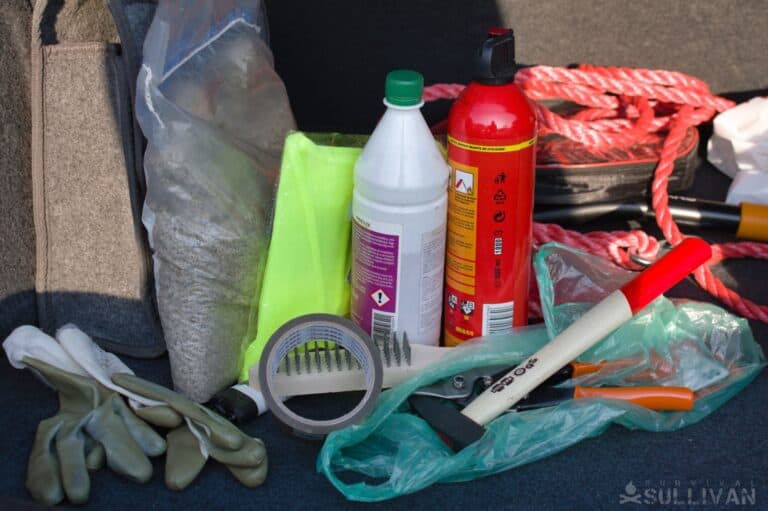
The desire to be prepared for a wide variety of emergencies is why many people supplement EDC kits with a get home bag (GHB) and a car BOB.
But EDC takes on a whole new meaning if you are someone who spends a lot of time in your car while traveling from place to place. Sure, you’ll have some items that you carry with you every day just like every other prepper.
But as a professional driver using your vehicle for expanded storage of EDC items increases the odds that you are prepared at any given time.
In all likelihood, if you’re a professional or commercial driver, when SHTF you may be hundreds of miles from home.
This puts you at a distinct disadvantage compared to others who are closer to home or work when something happens. It means you will have much farther to travel in order to get home to your family if that’s part of your plan. You will need more supplies.
Along with the increased odds that you will be farther away from home when SHTF, you also have a lot more interactions with a variety of unfamiliar people on a daily basis. This puts you at a greater risk for carjackings or other crimes where you need to defend yourself.
Many commercial drivers must deal with people who are angry, rude, intoxicated, ill, and even violent. If you’re in your vehicle for most of the day or travel frequently, you’re also at an increased risk of being involved in or witnessing a car accident or other roadside emergencies.
Below is a list of the EDC items that most people consider essential for survival when things go awry on any given day.
Of course, whether you can carry a gun or a knife will depend on the area you live in and what the laws are for your area and for the areas you will be traveling through on any given trip.
Make sure you thoroughly investigate laws in the states you will be traveling to and from no matter what kind of vehicle you drive.
Table of Contents
Critical Items
These are the items that you shouldn’t leave home without when traveling my vehicle, and in some cases cannot leave home without! Included here for completeness, these are basically default parts of your travel EDC.
Keyring and keys
Obviously, your car is not going to go very far without the key to operate the ignition! This might be seen as the most mundane part of your kit but even here there is room to tailor it towards survival purposes.
A small glow fob to let you locate it if it is ever dropped in the dark or the power goes out could be useful, as could a tiny Swiss army knife or a small Firefly flashlight.
Cell phone and a car charger
It is hard to imagine modern Life without some sort of cell phone.
Despite what curmudgeons might tell you they actually have a lot to commend them for survival purposes, and are an excellent communications resource aside from being packed with tons of capability for other things, from note-taking to navigation and even the storage of manuals or maps.
However, they are only as good as long as the electricity in their batteries lasts, so include a car charger with your vehicle at all times.
Wallet / Purse
This should be absolutely self-explanatory to every adult. Your wallet holds cash, cards and all the other accoutrement needed to navigate the winding corridors of commerce the 21st century along with your…
ID
Being able to prove that you are who you say you are could be important in any number of emergencies, as could proving you are a sworn officer for any given agency. Always carry ID with you!
Insurance Card
If you are driving on the highways and byways of America in the 21st century you have to have insurance, no questions asked.
Proof of insurance should be a standard part of your vehicles on board compliment, and keep it with your registration so it is handy in case you need to produce it for law enforcement. It might also be worth keeping a spare insurance card in your wallet, just in case.
Decoy Wallet
If you live in a high crime area, or one where pickpocketings, muggings and robberies are common, consider investing in and assembling a decoy wallet, which is a cheap or old wallet with no more than $20 in small bills in it along with useless gift cards or fake credit cards.
Something like this is convincing enough that you could hand it over or drop it and run to cover your escape in case you are held up.
Vehicle EDC Items Checklist
If you do find yourself stranded on the side of the road for several hours or even overnight, you will want to have some or all of these survival items on hand:
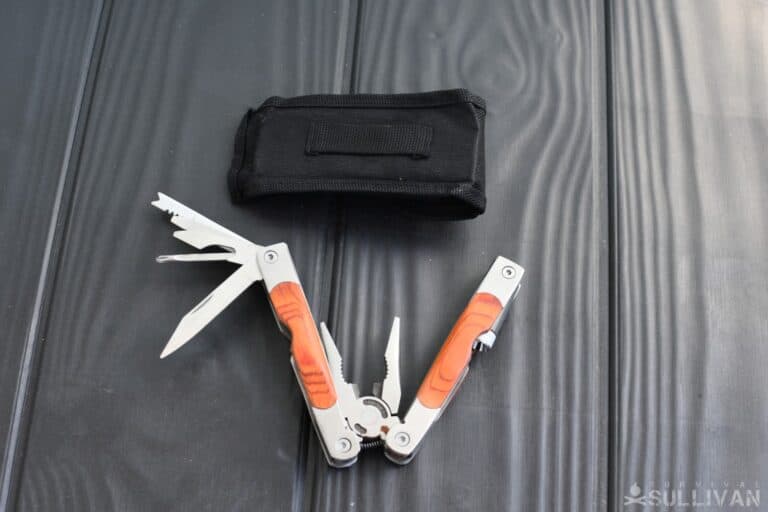
Multi-tool
A proper multi-tool, the kind that features an incorporated set of pliers, is an invaluable item to have with you anytime you are on a vehicular adventure.
Although not a replacement for a proper set of emergency tools, the average, heavy duty multi-tool is good enough at enough tasks to help you take care of business when conducting simple repairs on your vehicle itself, or handling some other DIY business near the roadside.
Pocket knife
You shouldn’t need me to tell you if you have been in the prepping game for any length of time, but you should never, ever leave home without a trusty knife of some kind.
For outdoor survival enthusiasts, a fixed blade knife is usually best but for urban and suburban environments you can definitely get by with a folding pocket knife so long as it is a strong one. You will use it for all the usual survival tasks should you become stranded but it also serves as a last-ditch self-defense weapon.
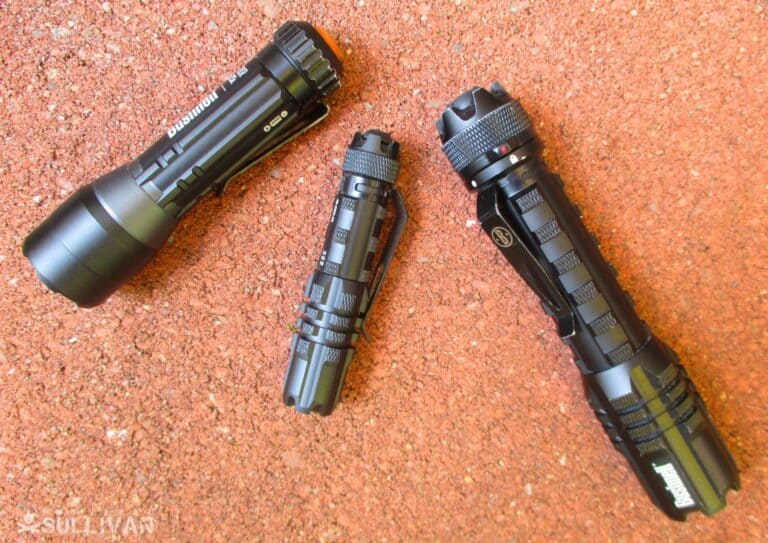
Flashlight
The flashlight is another tool that no prepper should ever leave home without. It has innumerable uses when the light is low, and keep in mind this is not just a night time inclusion.
Many large buildings and especially basements can become pitch black mazes should there be a power outage, and you might need to illuminate any darkened space when searching for someone or something.
Consider two the utility and increase in safety that a flashlight brings to any scenarios in low light and you should see the value.
Notepad and Pen
A compact notepad and pen is always a good idea to keep handy in the vehicle. When time is short it is invariably faster to simply whip out a pad and pen and get to writing down critical information versus opening your phone, unlocking it, navigating to a note app and then begin typing or dictating.
It could be the description and license plate of a hit-and-run driver, directions to A safe Haven, details about an ongoing disaster overheard from a radio broadcast or anything else.
Handgun
The World is a dangerous place, full of monsters, and every single one of them are allowed to bite the unwary and the innocent. Accordingly, a firearm is your best lethal Force option for defending yourself against evil.
A full discussion of the specific factors influencing the choice and motive carry of a handgun or beyond the confines of this article, but for now all you need to know is that you need to have one, you need to know how to use it, you need to keep it loaded and you need to keep it on you.
Paracord
Cordage is a simple tool that is invariably taken for granted by most people. Cord and rope of all kinds allow us to do work in unique and interesting ways, and often achieve it in such a manner that would be impossible or clunky via some other method.
You’ll use cordage for improvised repairs and construction along with countless other utility tasks, so make sure you keep a small coil in your vehicle wherever you go. Paracord is an extremely strong and ubiquitous option.
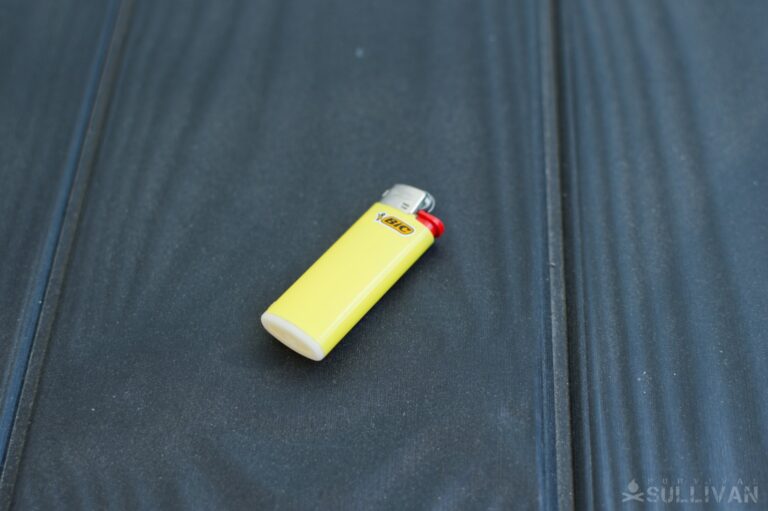
Lighter
Most humans have enjoyed the privilege of making fire for eons, and it is again one that we take for granted today since modern climate control, including climate control in our vehicles, is ubiquitous.
That capability can be snatched away in a second, so having a reliable way to make fire on your person at all times is mandatory. The cheapest, most reliable and quickest way to do that is with a common lighter. Toss a couple into your kit.
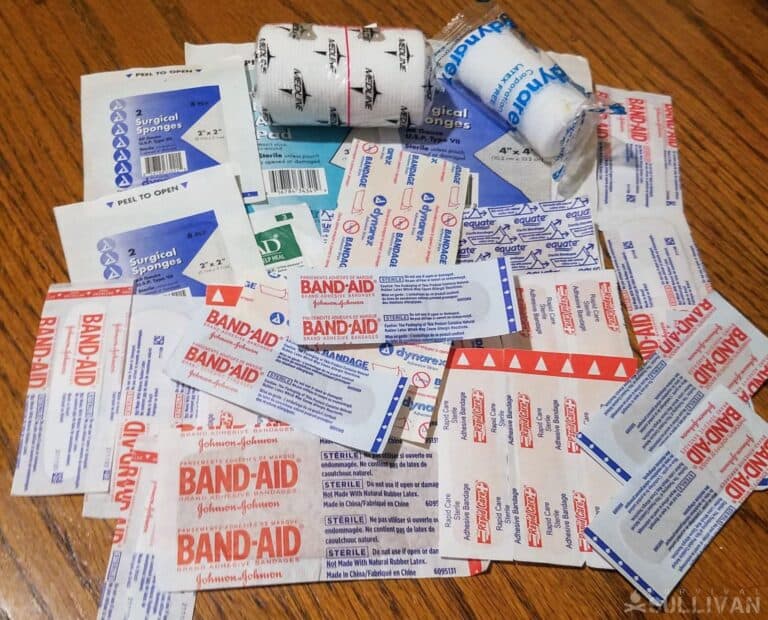
Band-Aids
Accidents, disasters and misadventures all have several things in common, but one of the most common of those ties that bind is the likelihood of injury.
If you are lucky, you’ll get away without major injury but in a survival situation even small wounds can become infected, and that infection can turn into a life-threatening showstopper. Take care of the small injuries before they turn into big problems with Band-Aids.
Magnesium Fire Stick
For heavy duty Fire starting tasks, especially in damp conditions or when using less than ideal tinder and fuel, a magnesium fire stick will provide all the heat you can handle and then some.
By shaving off a few small flakes and placing them on your tinder bundle before igniting them you can create a powerful blaze that cannot be put out until the magnesium is consumed.
Neosporin
Consider the Neosporin a companion prep to the Band-Aids above. Covering a cut is one thing, but chances are the vector for infection is already working against you before you even doctor it when you are in the middle of a crisis.
Neosporin is an antibiotic ointment that will snuff out those nasty little germs while helping your wound heal along with providing some pain relief. A small tube takes up very little room and weighs virtually nothing.
Bottled water
It is difficult to overstate just how precious water is in a survival situation. Out of all the survival necessities, water only comes in behind air much of the time, and is sometimes only superseded by shelter in the most hostile of climates.
A large jug of bottled water, or a water bottle that you bring yourself, filled at home, will give you a ready and sure supply of drinking water that you can depend on during a roadside excursion.
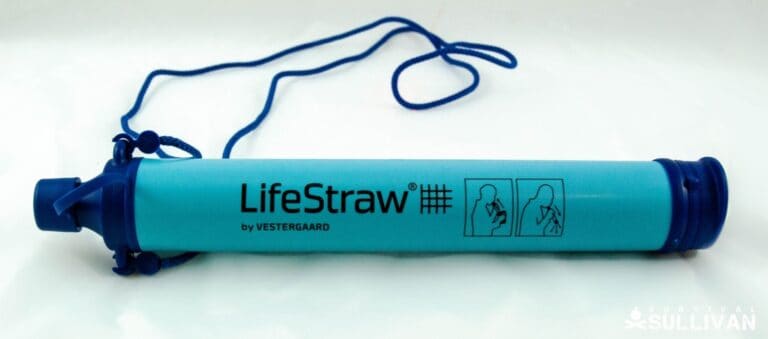
LifeStraw
Continuing with the hydration support survival gear, the LifeStraw is an ultra compact water filter that is inexpensive but nonetheless highly effective water filter that is used in a manner that the name suggests, as a giant drinking straw.
When inserted into a questionable water source, you can drink from it directly safe with the knowledge that dissolved solids and potentially dangerous microorganisms are being removed.
Maps of the area
GPS systems, be they built into your phone or built into your vehicle, are great and you can generally rely on them so long as you understand their limitations but you should never rely on them to the exclusion of more traditional methods of land navigation.
A comprehensive road atlas, local city and county maps and Regional topographic maps should all be a part of your vehicular EDC kit.
Compass
The natural and perpetual partner to a good map is an equally good compass. Sure, if you never leave your hometown you can probably find your way without one, but you should not risk getting lost for a want of basic, reliable direction finding capability.
A field or lensatic compass is a good inclusion if you have a long way to travel and know how to use one, but most folks can get by with a compact but high quality button compass.
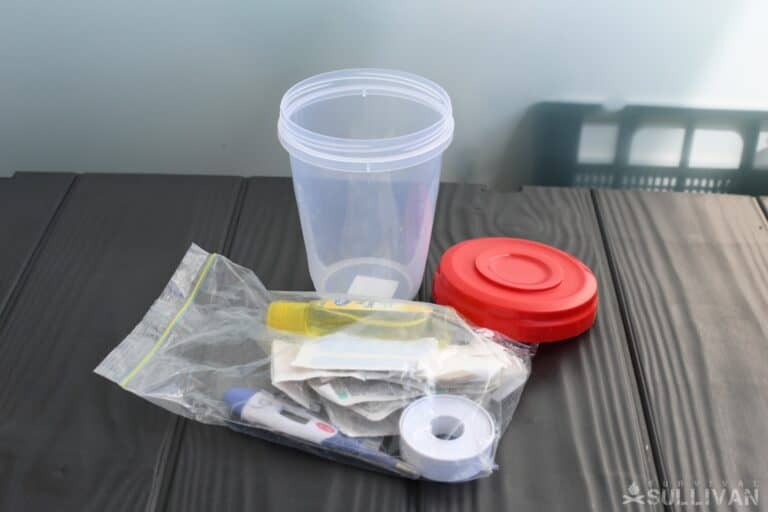
First-aid kit
Accidents and disasters, especially those involving vehicles, usually entails some pretty substantial injuries in the form of lacerations, penetrations, fractures and burns.
Equip your first aid kit accordingly with all the supplies you need to treat such trauma. Like many things on this list, the supplies are no good without the skills, so make sure you skill up and know how to deal with various injuries.
Emergency Blanket
you have probably seen these gold or silver, crinkly tarp like blankets wrapped around people at the scene of various accidents when first responders show up, and though they look like a gimmick or a product designed to entice bean counting acquisition employees in various departments, they really, truly do work.
Emergency blankets can reflect up to 90% of the body heat emanating off of a person back on to them, helping to keep them toasty warm. They are cheap, ultra compact and virtually weightless, get some!
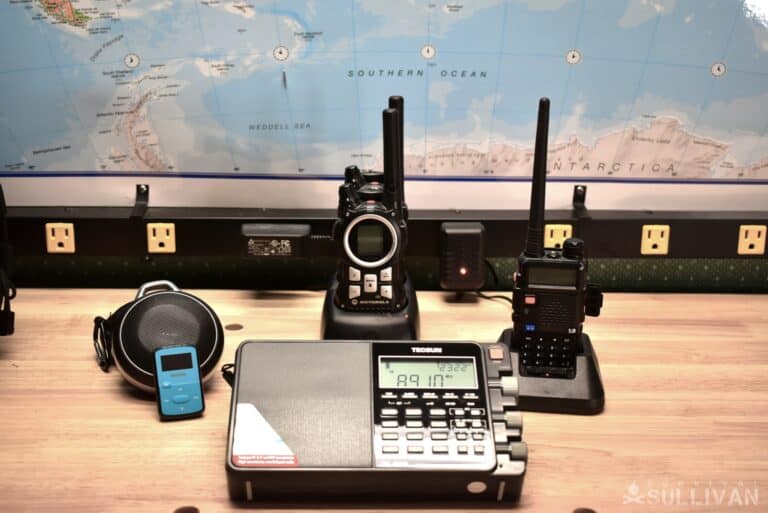
Two-Way Radio or CB Radio
Reliable communications is essential in all kinds of survival situations, especially ones where you might be traveling by vehicle and well away from civilization. In austere conditions or times of trouble radios will likely prove more reliable if shorter ranged than cell phones.
A handheld or vehicle mounted radio could be the lifeline you need to summon help or communicate with others in your group. Using a radio is nowhere near as simple as placing a call with a cell phone, so you’ll need to school up to make the best use of it.
Fishing Kit & Collapsible Pole
Compared to hunting and many forms of gathering, fishing might be an easier and more reliable way of obtaining extremely nutritious and high quality calories in a survival situation. Any place that can support large bodies of water will support fish and other marine wildlife.
With just a little bit of skill and a modest kit many are easily caught, even in the middle of a survival scenario. Instead of taking your chances with a tiny, pocket-sized fishing kit found in typical survival kits, include a proper one with an ultra compact, collapsible pole in your vehicle if you live in such a place.
Emergency car kit
Your vehicular emergency kit should include everything you need for dealing with an accident or a roadside incident. reflector triangles, strobes, Jack and lug nut kit, a basic selection of spare parts and tools, spare tire, tire repair kit and more should all live in your vehicle permanently and be regularly tested for function and service life.
Comfort and Convenience Items
Though they might seem like luxuries, items that are designed to help you keep your head in the game or provide a little bit of comfort or relaxation are great inclusions in a vehicle, considering it can carry far, far more gear than you could when traveling on foot.
A little boost to morale is always a good thing! The glove compartment or center console is a good place to store comfort and convenience items including:
Car sickness bags
Some people get car sick and just cannot help it. Even worse, and seemingly spontaneously, some adults develop car sickness as they get older.
This might be you or one of your passengers or it might not be, but even if they are just suffering the after effects of that ill-advised meal of gas station sushi you’ll be glad you have an extra large, extra sturdy sealing plastic bag to handle unfortunate bout of vomiting while underway.
Hand cream
Dry, cracked hands are painful and will corrode your patience with every action they take, including holding the steering wheel.
A small tub of hand cream or other lotion can help keep hard-working hands in the game longer. Take great care if you use this immediately before getting back behind the wheel, because it will compromise your grip for some time.
Chapstick
I think everybody understands the value of chapstick. Exposure to wind, sun and cold conditions will turn your lips into a jagged, cracked mess that looks closer to the surface of Mars then a part of a living human body. A tube of chapstick will easily prevent and help remedy such a condition.
Napkins
It never fails that you’ll be out of napkins when you need one, so think ahead and include a stack of them in your car. For cleaning up small messes or just wiping grease from a road trip munchie meal off your fingers napkins are ideal, sanitary and entirely disposable.
Hand sanitizer
Many times out on the road you’ll have cause to wash your hands but you won’t have any running water or soap, or else you won’t have any water to spare for the purpose in a survival scenario. This is where hand sanitizer can absolutely save the day.
A little dollop, some brisk rubbing and you can go forward sure that all of the harmful germs on your hands are history. Even better, if it spills inside the vehicle it will just eventually evaporate into nothing rarely doing much harm.
Gum or candy
Having something to chew or suck on can help pass the time on a long road trip or during a long wait on the side of the road after a breakdown.
Chewing gum of any variety or hard candy that will not melt in the high heat of a vehicle interior is a great comfort item to squirrel away for a rainy day.

Dried fruit and jerky
This is another good option for rations inside your vehicle, as both are easy keeping, long lasting, nutritious and filling.
If you are working hard or are forced to try and get a vehicle out of a bad situation by brute force or even hike away from your wrecked vehicle, you’ll need energy for the Long haul. Beef jerky and dried fruit provide quick calories and generally well rounded nutrition for the purpose.
Extra blankets
If you are stranded with your vehicle and cold conditions it is going to get colder than you think inside that car or truck when the heater isn’t running.
The ability to bundle yourself up like a big burrito with a proper blanket will go a long way towards keeping you toasty and relatively comfortable under the circumstances. Remember, hypothermia is a consistent and effective killer in every kind of survival scenario!
Reflective vest
There is a reason that every single worker, state employee, operative and spectator who is near a roadway where motor vehicles operate whereas a garishly bright and extremely reflective vest.
Being seen means staying alive in any area where human operated heavy equipment is in use, and you had better believe this counts for common automobiles on American roadways.
If you have to travel along a road on foot or just dismount to work on your own vehicle, don your reflective vest and you’ll dramatically decrease the chances you’ll be mown down.
Hammer
Specifically a vehicle extrication hammer. These ingenious devices look sort of like a smaller Carpenter’s hammer, only instead of a nail pulling claw on one side opposite the strike face they have a conical, pry that will easily shatter automobile glass and help wrench open stuck doors.
The strike face is stout and remains useful for all of the tapping and banging that is sometimes necessary to affect repairs on a vehicle.
EDC Items for Repairs
Consider using part of the far back of the trunk space or another out of the way area for a duffel bag or other container to store items such as:
Spare fuses, brake light and turn signal bulbs
It never fails that you will have a bulb burnout, systems go offline or some other minor but aggravating and potentially infractions mishap occur while you are on the road.
Best case scenario, you could get pulled over and warned for a violation or even ticketed. Worst case scenario, you reduce your visibility and are unable to signal your intentions to other drivers, perhaps starting a domino reaction crash. Keep spare bulbs and fuses on hand in your vehicle.
Extra engine oil and brake fluid
Vehicles of all kinds rely on oil to lubricate their engines, and even the best maintained and newest vehicle will consume it as a resource. This means you must be prepared to replace it when the oil level is low, and a leaky oil system could result in a catastrophic loss of oil that necessitates a top off on the road.
Brake fluid is less likely to leak over time, but if it does your brake system will lose efficiency. Be prepared for both outcomes by carrying a small quantity of each aboard your vehicle.
Antifreeze / Coolant
A loss of antifreeze / coolant in a vehicle will turn into a showstopper in very short order. If there is a leak that you can prepare, you’ll still need to replace the fluids that were lost so you had better have some antifreeze on hand.
Also keep in mind that you might be able to help another traveler in a jam or someone that is convoying with you who needs it.
Gloves
Believe me when I say that any roadside mishap or accident is going to involve getting dirty if you want to fix it. Vehicles are perennially dirty and greasy, and other hazards abound, from broken glass to twisted metal and hot piping or body work.
Protect your hands from all of the above and perhaps cut down on the crud that will get on your clothes and back in the vehicle by wearing a good, sturdy pair of gloves.
Duct Tape
Duct tape. You know it, you love it, get some. Duct tape is a prepper’s best friend, and is useful for innumerable repair tasks as well as improvisational construction.
You should have a huge role in your vehicle at all times. This is one of those things where you really do get what you pay for, so spring for a high-end brand consisting of a heavy duty fabric backer and super strong adhesive. T-Rex tape and gorilla tape are both good.
Tire iron and jack
A tire iron and jack are mandatory inclusions for every, single vehicle. Without them, you will not be able to lift up your vehicle in order to change out a flat or destroyed tire, which I would remind readers is the number one failure that is likely to befall the motive system of the vehicle.
Your tire iron, properly called a lug nut wrench, is size to fit your specific lug nuts. If it does not have an extension bar to provide you adequate leverage consider investing in a long-handled model.
Power steering fluid
Power steering fluid is another liquid that is unlikely to be consumed in the course of normal operation, but you definitely don’t want to go without power steering for any amount of time. A small bottle is usually more than enough to top off a system that runs low for any reason.
Brake Adjustment Tools
Tools to adjust your car’s brakes and brake system components are an often overlooked but compact and useful inclusion for emergency roadside repairs. Any failure in the braking system is a major emergency, and even comparatively serious problems might be simple and easy to solve only if you have the right tools.
Especially for Preppers who are depending upon their vehicles to ferry them out of danger these tools are a wise inclusion if you have the room.
Ratchet Straps
Ratcheting tie down straps are ubiquitous items that will help you secure cargo on a trailer, in the bed of a pickup truck or even on the roof cargo rack of other vehicles.
They work wonderfully for this purpose and are quite affordable in the bargain. They also have some utility for holding on damaged body work after a collision.
Channel Locks and Vise Grips
an indispensable part of every single toolbox, part of a vehicle kit or otherwise, that could ever or will ever exist channel lock pliers and vise grips are absolutely indispensable when you need to put serious gripping or clamping force on a stubborn part or free up a stuck and mangled fastener when all other methods have failed.
Spend the money for good ones and treat them right because they will save your bacon when you need to fix something.
Tow chain or strap
Even if your vehicle is not particularly capable of doing much towing or snatching you should still consider bringing along your own towing straps or chains. 15 feet or more of tow chain and/or 30 foot 20,000 pound tow strap should be enough for most scenarios.
Chains are traditional, but modern synthetic fabric tow straps have proven to be broadly Superior and pretty much all regards and are far safer should disaster occur while vehicle recovery is in progress.
WD-40 or other lubricant
WD-40 and other penetrating oils are useful for short-term lubrication of dried out components, although it is not a particularly great lube, but it’s intended purpose of loosening frozen, Rusty fasteners and other parts makes this stuff worth its weight and gold when you just can’t get that last nut worked loose.
Tire repair kit
A functional tire repair kit will contain a plug kit and compact air compressor to help you fix a puncture through the tread of a tire and air it up in short order.
Compact air compressors that run off of the vehicle’s own power supply can definitely do the job, but there are many cheap and chintzy ones out there, so make sure you test any perspective one for performance before you rely on it.
Gasoline siphon and funnel
A gasoline siphoning and funnel kit will allow you to recover fuel from your own tank or that of another vehicle so that you may repurpose it into a container.
If a Good Samaritan comes along (or someone else in your party), and has fuel to spare you can easily draw it out of their tank using a siphon with no need to head to the gas station, get a gas can, fill it up and then return before you can refuel. It can also allow you to draw out bad gasoline from your tank before it further damages your engine.
Ice / Snow Scraper
Any vehicle that is exposed to cold weather, especially in damp conditions or to proper precipitation, can start to ice over.
This is especially problematic on the windshield and windows, but icing on the body can add considerable weight. An ice scraper will take care of the issue easily enough and hopefully before it gets too bad.
Come Along
Think of a come along as a giant ratcheting strap designed to help you self recover your own vehicle.
Purpose-made come alongs are widely available, and easy enough to set up and use so long as you have a heavy duty hardpoint nearby that can support the weight of the vehicle and the force needed to pull it free of a stuck position.
Spare gasoline can
This is an elementary inclusion but one that is definitely worthwhile if you have the space in your trunk or cargo bay for it. A spare, clean and empty gasoline can will provide you with the right container for collecting gas from a nearby station or from a Good Samaritan who stops to help you.
Don’t be like so many people of social media infamy who risk life, limb and vehicle trying to transport gas and unapproved containers.
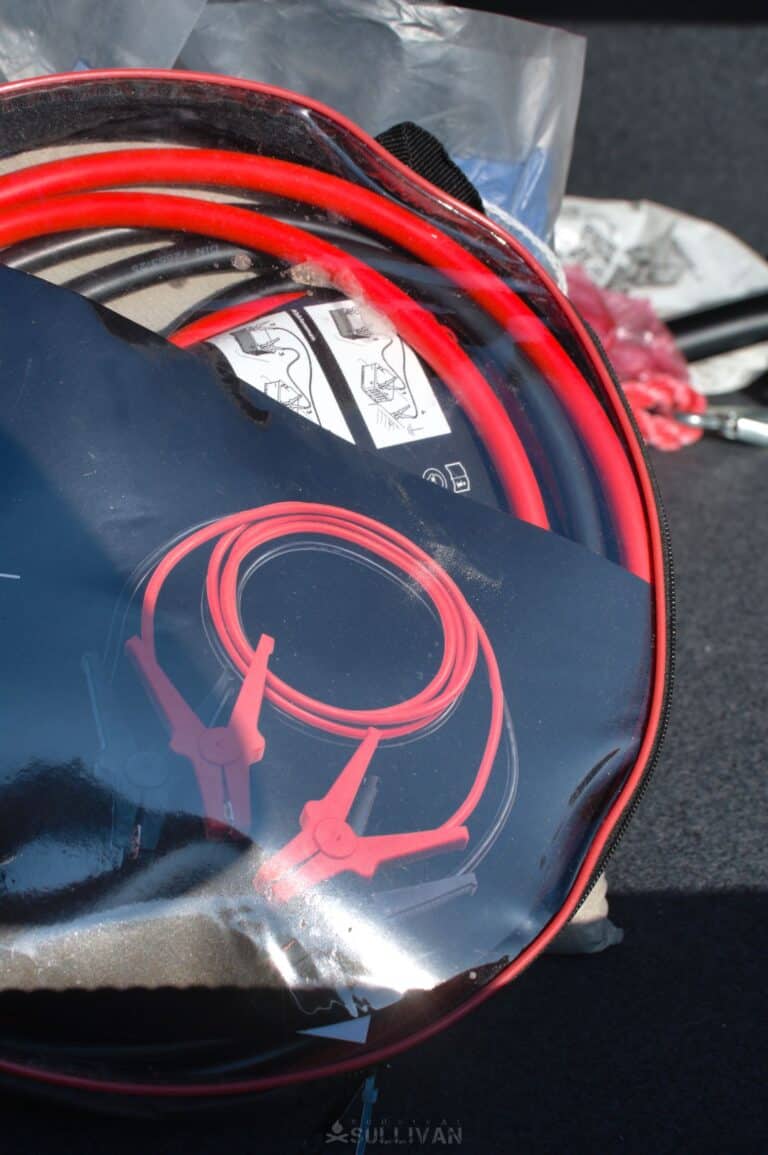
Jumper cables
Dead batteries are another extremely common cause of an inoperable vehicle, but luckily one that is very easy to correct, at least temporarily, so long as the battery is an otherwise good health.
You can use jumper cables to push a little extra electricity into a dead or dying battery in order to start the vehicle that it is installed in. once the vehicle is running, the alternator will take care of the rest, at least for a time.
Clothing Items
In a SHTF or other emergency, a change of clothing that is warmer and/or more durable if you break down or are stranded or have to strike out on foot for some reason.
Change of clothes (seasonally appropriate)
No major surprises here. A spare set of clothes that are appropriate to both the overall climate in your area and the season you are in is a great inclusion in any vehicle EDC kit.
Ideally, they will be comfortable, easy to work in and easy to walk in. chances are if you need to change into them you were going to have some hard work ahead of you, so plan accordingly.
Sturdy shoes
Same advice as above. If you don’t normally wear boots or shoes that are suitable for walking, working and getting a little dirty keep an extra pair in your vehicle even if they are a little old and tattered. It will be better off than trying to go the distance wearing shoes that are completely unsuited to the task.
Wool socks
Wool socks are a tremendous compliment to a good set of footwear. They will keep you warm and cold weather, cooler and warm weather and provide excellent padding to help prevent blisters.
Though they take a long time to dry out, wool is a natural antimicrobial fiber and they generally don’t get funky and stinky unless they are horrendously neglected. So long as moths don’t get to them you can put these away in your vehicle and forget about them.
Winter hat
As mentioned elsewhere in this article exposure is a major killer that is highly reliable whenever the temperature starts to dip.
You lose a considerable amount of heat out of your head, and some parts of your head, particularly the ears, are highly vulnerable to frostbite, so make sure you keep an appropriate cold weather hat of some kind in with your change of clothes.
Winter gloves
Like your face and head, your hands and especially your fingers are particularly vulnerable to frostbite and extremely cold conditions.
Even if you aren’t in a place so bitingly cold, coldness can quickly numb your hands and render them more or less useless for the delicate work that is sometimes required to get a vehicle back on the road. A good set of winter gloves will help keep your hands warm.
Thermal underwear
If you live or travel regularly through the coldest regions or will be traveling during a particularly cold season, consider including a set of thermal underwear with your seasonally appropriate clothing mentioned above, and this assumes you don’t already wear them habitually.
A climate-specific set of underwear makes a tremendous difference in your overall level of comfort and warmth in such harsh conditions.
Sunglasses or prescription glasses if applicable
Sunglasses are stylish but they are also entirely practical when operating a vehicle.
Glare from the sun cannot always be effectively blocked out by a visor while maintaining on appropriate view of the road and your surroundings. Even if it can, glint off of asphalt, shiny surfaces and other reflective elements can strain your eyes over time.
A spare pair tossed in with your other clothing is a good hedge against loss or damage, as is a set of prescription lenses if you depend on them.
Raincoat or poncho
It never fails that when you need to stop the car and get out you won’t have any overhead cover and it’ll be raining cats, dogs and pitchforks.
Keep a heavy duty weatherproof raincoat or poncho as part of your vehicular preparedness kit and you won’t have to get drenched to the skin whenever you need to hop out during a shower or thunderstorm.
Hand and Foot warmers
Hand and foot warmers are your best friend when you have to be outside and working without gloves on to accomplish an objective. Hand warmers in particular can be placed into a pocket and your hands kept near them to stay toasty warm and nimble no matter how cold it gets outside. The same thing can be said for foot warmers.
Coveralls
For dealing with the worst accidents or mishaps that are recoverable without ruining your plans, a disposable set of coveralls can protect your clothing and keep you from looking like a wanderer of the wilderness when you get done. When your task is complete, coveralls can be shucked off, turned inside out and disposed of or stored with no fuss and no muss to be dealt with later.
EDC Items to Help in Case of Car Crash
Road flares
Road flares are an old but time-tested resource for increasing visibility and providing some useful ambient light in the event of a crash.
National highway safety administration and Department of transportation test protocols have revealed time after time that nothing is as visible or more attention getting than a fiery, chemical road flare, and you can depend on road flares burning in all weather conditions for quite a long time.
Glass breaker
A glass breaker is a vital vehicle extrication tool that can help you get out of your car or truck in a great hurry should the doors become jammed or you wind up crashed into an obstruction that prevents the doors from opening, such as a body of water.
Generally consisting of a fixed or spring loaded hardened, carbide Spike these are easily capable of shattering a side window with very little effort, allowing you to escape so long as you are able to get free of your seatbelt. Speaking of seat belts…
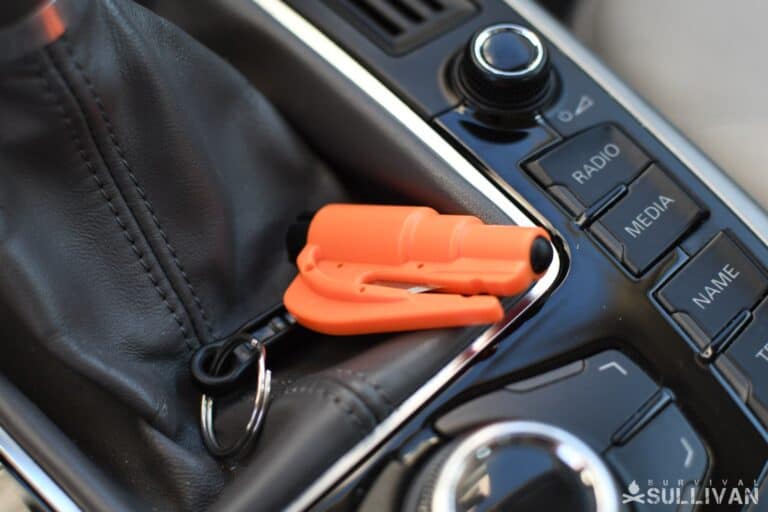
Seatbelt Cutter
The seatbelt cutter is the perfect complement to the glass breaker above, and many units on the market integrate these two tools into a compact form factor to serve as an all-in-one device that can be attached or stored handily in the passenger compartment.
A seatbelt cutter consists of a recessed, angled blade of razor sharpness it will easily slice through the tough webbing of modern shoulder and lap belts. Sure, you could risk using your knife or some other cutting tool for the task, but your risk self-injury and there are never as swift or sure as a good seatbelt cutter.
Fire extinguisher
Automobile fires cause millions and millions of dollars in damage every year and cost hundreds of lives. You have virtually no chance of halting on automobile fire without a properly rated fire extinguisher on hand and ready to go.
The trick is to get one that is compact enough to keep handy inside the vehicle but large enough to do the job. Make sure it is installed in a proper mount so it does not roll around or turn into a missile during a collision.
Job-Specific Vehicle EDCs
Chauffers, Taxi, and Uber Drivers
If you make your living transporting other people to their destinations then you must be prepared without making yourself a target.
Consider carrying more items from the customer convenience and comfort category even during normal times in the event of major delays due to traffic or weather.
In addition, your own personal security and that of your riders will be of more importance. Make sure you know what company policy and state laws dictate about the types of self-defense weapons you can legally carry in your vehicle.
Semi-Truck Drivers
As a semi-truck driver, especially over the road, you will spend much of your time miles or hundreds of miles from home. You’ll be more likely to be stranded on the side of the road due to a traffic jam or severe weather, sometimes overnight.
Most semi-truck cabs are equipped today with sleeping quarters if you have to pull over and as long as you have fuel you should be warm. Semi-truck drivers who are over the road may want to have a fully equipped BOB in the event SHTF while you are on the road.
Security and self-defense can definitely be an issue but make sure you are aware of your company policy regarding concealed carry.
If you own your rig then you need to fully understand the proper CCW permits for any areas that you may travel through on your route.
In some cases, if you are caught with a handgun in a commercial vehicle, you can go to prison for five years. Many weight stations are now equipped with X-ray machines which can detect hidden guns.
Bus Drivers
The EDC items to keep in your vehicle if you drive a bus for a living will be customized differently if you are a school bus driver, a city bus driver, or a charter/tour bus driver.
Professional bus drivers who transport children or families will need to be more prepared to provide for the safety of passengers.
Considering the increase in security issues aboard buses, you will want to know what your company policy is regarding self-defense weapons you can carry.
If your bus full of passengers becomes stranded in a traffic jam or severe weather, you’ll want to be prepared to keep them safe and content in order to prevent tempers and panic from getting out of control.
The items in the comfort and convenience category will help people remain calm. It might benefit you to also carry extra bottled water, snacks, and even a portable toilet if your bus doesn’t have one built in.
Construction Industry Drivers
As a construction industry driver you may be more likely to be on scene when someone experiences a traumatic injury such as a severe laceration, broken bones or concussion from a fall, or even a crushed injury to an extremity.
You may be parked on the side of the road when a co-worker is hit by a passing car. Having supplies on hand to temporarily treat yourself or someone else medically until help arrives if it’s available, can save lives.
Pay special attention to the comfort and convenience and clothing categories so that you can be prepared to prevent or treat dehydration and hypothermia both of which can be real threats for those who work in the construction industry.
EMT / Paramedics
Obviously when it comes to medical supplies for survival, EMTs, and paramedics have a variety of supplies that must be stocked so they can tend to patients while en route to a hospital.
But think about what additional supplies you would need if you were first on the scene because you drove past an accident scene on your way back from a hospital run or if your ambulance was hijacked or broke down during a SHTF situation.
You could need to defend yourself or make a minor repair so you can get back on the road quickly. Having additional supplies might even mean you can get someone free of a car in time to save their life if their car is underwater or on fire.
Delivery Drivers
This category of drivers includes a wide variety of people who must drive to deliver or pick up items. Delivery drivers can include pizza or take-out delivery people, postal workers, UPS, and Fed-Ex drivers as well as moving truck and furniture delivery drivers.
For the most part, these drivers are in their own vehicle or a company vehicle and have multiple stops in a particular area.
If you own your car, obviously you can carry more EDC items than someone who shares a company car.
But every delivery driver should be prepared with extra pens, maps of the area for when the GPS isn’t working, weatherproof shoes or boots, a raincoat with a hood or a waterproof poncho.
Because you must travel to the houses of people who are unfamiliar to you, self-defense becomes a priority for delivery drivers too. We’ve all heard stories of postal and UPS drivers being attacked by a dog.
Always check your company policy before deciding what weapons to carry for self-defense. In most cases you should be okay with discreet self-defense EDC weapons like a sap cap for example. No one knows it’s weighted unless you have to use it.
Sales Reps
If you spend time in your car because your occupation requires you to travel to different areas to sell products and represent your company, you may dress more formally most of the time.
Women especially may be required to wear a suit or dress which can restrict movement in the event of an emergency. As a sales rep you may want to pay more attention to items from the clothing category to ensure you are prepared to stay warm.
On top of the supplies listed above, sales reps need items during “normal” days that other people may not.
Just in case you need to modify or throw together a presentation, and close that sale, keep a stock of extra office supplies in a container in your trunk such as:
- extra computer paper
- Glue or scotch tape
- Scissors
- extra company pamphlets
- foam core panels for presentations
- Markers
- Velcro
- Flash drive with company letterhead saved on it
- Spare laptop battery or wall charger
Keep in mind these items will also be useful in get home and SHTF situations, so you can consider your car’s EDC kit to be more or less the same with your car’s bug out bag.
If you’re someone who travels frequently for work, consider using your vehicle to carry additional survival supplies. Even without a SHTF event, there are times when we could help ourselves or others if only we had the right tools and equipment on hand when something unexpected happens.
Did we miss any items for your car, you think should be included? Let us know in the comments below.
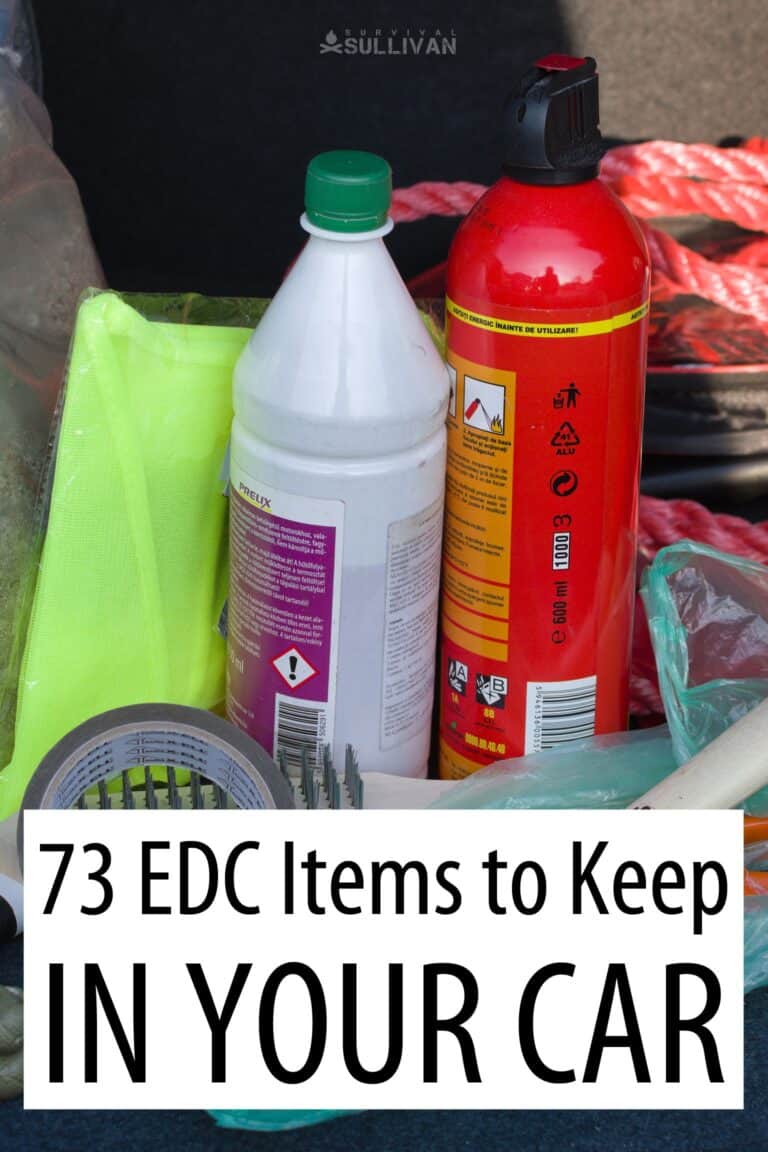

Born and raised in NE Ohio, with early memories that include grandpa teaching her to bait a hook and watching her mom, aunts, and grandmothers garden, sew, and can food, Megan is a true farm girl at heart.
For Megan, the 2003 blackout, the events of 911, and the increasing frequency of natural disasters like Hurricane Katrina, spurred a desire to be more prepared. Soon to be living off-grid, this mother of four and grandmother of ten is learning everything she can about preparedness, survival, and homesteading.
